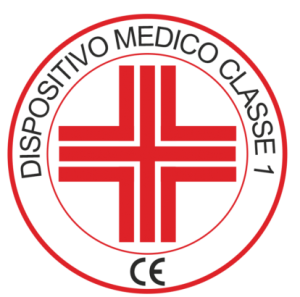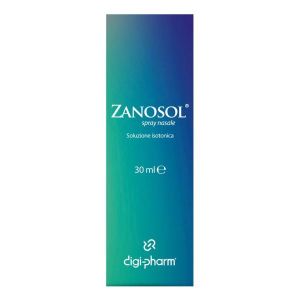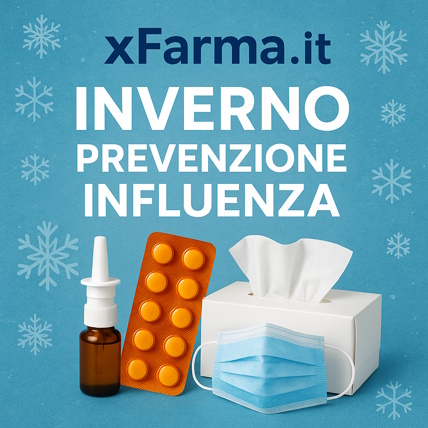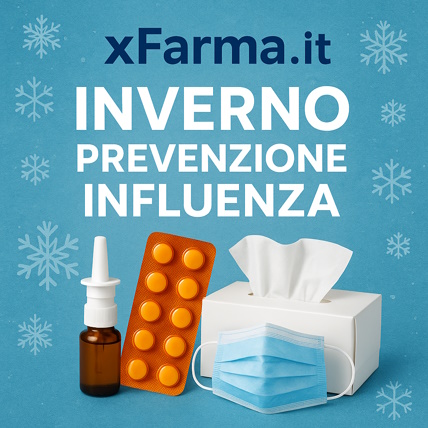Ship in Europe, Find out rates!
Language
Zanosol Nasal Spray 30ml


Regular Price
€24.99
Special Price
€22.08
-12%
Save: €2.91
In stock
Recent lowest price:
€22.02
- box Delivery in Italy in 24/48 and free returns
- star3.000+ positive reviews
- dropboxOver 60,000 products in the catalog
Z ANOSOL
nasal spray
nasal spray
Composition
Purified water; sodium hyaluronate; sodium chloride; sodium benzoate; vitamin A.
Therapeutic category
product.
Indications
Zanosol nasal spray is a product in isotonic solution with hyaluronic acid and Vitamin A.
It is indicated in the case of dryness of the nasal mucosa of various origins, it creates an effective protective barrier against external agents by reducing excessive nasal secretion.
Hyaluronic acid hydrates and lubricates the nasal mucosa favoring, together with Vitamin A, the physiological repair processes of the nasal mucosa.
Zanosol is also indicated in children.
Dosage
2 sprays per nostril, 3 times a day.
Instructions for Use
1) Remove the protective cap from the dispenser.
2) Hold the bottle vertically and position the dispensing spout at the mouth of the nostril.
3) Press with two fingers on the base of the dispenser.
4) Repeat the operation with the other nostril.
5) Clean the dispenser.
6) Put the protective cap back on the dispenser.
Warnings
Store at room temperature away from light and heat sources.
Keep the product out of the reach of children.
Do not swallow.
Do not use the product after the expiry date indicated on the package.
Avoid splashing in the eyes.
In some cases the nebulization can cause a slight and transitory sense of local irritation.
Contraindications
Known hypersensitivity to the components.
The use of the product, especially if prolonged, can give rise to sensitization phenomena; in this case, interrupt the treatment and consult the doctor to establish a suitable therapy.
Package Contents
20 ml bottle with spray dispenser.
Use of hyaluronic acid in otolaryngology
The most frequent pathologies in the respiratory field, and in particular of the upper airways, are allergic and non-allergic vasomotor rhinitis and infectious forms, such as rhinosinusitis.
Vasomotor rhinitis, from a symptomatological point of view, are characterized by nasal congestion, sneezing, rhinorrhea and itching.
The allergic forms have a seasonality of the aforementioned symptoms unlike the non-allergic forms that persist throughout the year.
If not treated adequately, according to international guidelines, they can become complicated with the onset of asthma and rhinosinusitis and, for non-allergic forms, in nasal polyposis.
In the context of therapeutic strategies, an important role in the treatment of these forms of rhinitis can be played by hyaluronic acid, which would facilitate the restoration of the mucociliary clearance mechanism, or "cleaning" of the epithelial surface of the nasal passages, compromised by the pathology immunophlogistics.
In fact, a recent study, published on the International Forum of Allergy & Rhinology, demonstrated the effects of intranasal administration of hyaluronic acid on patients with allergic and non-allergic rhinitis by studying nasal cytology.
The study refers to 78 patients suffering from various forms of rhinitis, who were given corticosteroids and antihistamines plus, in a randomized way, hyaluronic acid or saline solution intranasally for one month.
At the end of the period a nasal cytology exam was performed on the patients to check for any changes in the presence of specific cells (neutrophils, eosinophils, mast cells and lymphocytes) in the mucosa.
In patients treated with hyaluronic acid and vitamin A there was a significant decrease in neutrophils (among the cells responsible for the disorders) compared to the average, as well as significant improvements in symptoms such as sneezing, rhinorrhea and nasal congestion.
Hyaluronic acid was also better tolerated in the month of treatment than hypertonic saline.
Ultimately, the results demonstrated that hyaluronic acid, administered in addition to intranasal corticosteroids and antihistamines, performs an effective action in the treatment of allergic and non-allergic rhinitis, leading to an improvement in various clinical and endoscopic parameters, as well as to be well tolerated by patients.
Also with regard to nasal-sinus infectious pathologies, the treatment with hyaluronic acid has proved useful in the post-operative period of patients undergoing FESS surgery (Functional Endoscopie Sinus Surgery).
This surgery is widely considered the standard of care in the treatment of chronic rhinosinusitis refractory to medical treatment, however this technique can lead to extensive crusting, mucosal changes and respiratory disorders, due to the presence of secretions, edema and post-surgical bleeding.
These problems can persist or worsen due to the alteration of the ciliary function caused by the surgery.
Also in this case, important researches published in international journals have shown that the local administration of medium-high molecular weight hyaluronic acid nebulizations is able to accelerate the "remodeling" process, or to shorten the healing times of the mucosa and reduce the inflammatory state.
Hyaluronic acid can also be used successfully for a longer period than immediately post-operative, so as to facilitate the complete remodeling of the nasal mucosa.
The role of hyaluronic acid in the "remodeling" process is fundamental from the point of view of the re-epithelialization of the mucosa, in association with vitamin A, which is facilitated by stimulating the growth of new blood vessels that bring nourishment to the cells.
It also acts in the prevention of the formation of biofilms, an important responsible for antibiotic resistance.
It can therefore be concluded that the topical use of hyaluronic acid nebulizations represents a valuable option in the management of the healing phase of the nasal mucosa following endoscopic surgery, favoring tissue repair and healing.
From a chemical point of view, hyaluronic acid is classified as a glycosaminoglycan.
The molecule is in fact formed by the repetition of long sequences of two simple sugars, glucuronic acid and N-acetylglucosamine.
These substances are both negatively charged and when they join together the strong repulsion gives rise to a linear, flexible and extremely polar molecule.
The great solubility in aqueous environment is important to ensure the hydration of the tissues while protecting them from excessive tension and stress.
At the same time, the high affinity with other hyaluronic acid molecules and with the other components of the extracellular matrix allows the formation of a dense and intricate network with a high molecular weight.
Its ability to bind water and other substances gives rise to protective gels, particularly useful for the skin.
By stimulating the formation of collagen and connective tissue, hyaluronic acid protects the body from viruses and bacteria, increases tissue plasticity and guarantees optimal skin hydration.
Hyaluronic acid is a fundamental component of the dermis.
However, its concentration within the connective tissue of the skin tends to decrease with advancing age.
If on the one hand this constant and considerable decrease is among the main responsible for skin aging, on the other hand the use of hyaluronic acid present allows to reactivate mature skin by stimulating cellular functionality and giving the skin its lost compactness and shine.
Medium-high molecular weight hyaluronic acid acts on the surface ensuring effective hydration and has a film-forming action by binding to the stratum corneum with a tensor and protective effect.
Vitamin A
Vitamin A is a fat-soluble vitamin, in nature it is found in different forms.
The term vitamin A indicates both retinol and its analogues, called retinoids.
Carotenoids also possess the biological activity of vitamin A as they can act as provitamins.
Vitamin A carries out a protective action on the mucous membranes and epithelia, helping to enhance their barrier value to infections. Vitamin A is a scar catalyst.
It exists in three main forms:
• retinol (alcohol);
• retinal (aldehyde);
• Retinoic acid, derived from the retinal, is found in animal tissues as retinol.
Hundreds of carotenoids are present in nature, but only a few have the ability to be converted into vitamin A.
The most common carotenoid in food is 13-carotene.
Vitamin A or retinol (consisting of 4 isoprene units).
It is found in foods of animal origin (liver, fish oil, fish, non-skim milk, butter, yolk).
Carotenoid (consisting of 8 isoprene units).
Carotenoids are present in plants; some have vitamin activity and are called provitamin A.
They are found in foods of plant origin (fruit, vegetables, olive oil).
Format
20 ml
Code DM001
Purified water; sodium hyaluronate; sodium chloride; sodium benzoate; vitamin A.
Therapeutic category
product.
Indications
Zanosol nasal spray is a product in isotonic solution with hyaluronic acid and Vitamin A.
It is indicated in the case of dryness of the nasal mucosa of various origins, it creates an effective protective barrier against external agents by reducing excessive nasal secretion.
Hyaluronic acid hydrates and lubricates the nasal mucosa favoring, together with Vitamin A, the physiological repair processes of the nasal mucosa.
Zanosol is also indicated in children.
Dosage
2 sprays per nostril, 3 times a day.
Instructions for Use
1) Remove the protective cap from the dispenser.
2) Hold the bottle vertically and position the dispensing spout at the mouth of the nostril.
3) Press with two fingers on the base of the dispenser.
4) Repeat the operation with the other nostril.
5) Clean the dispenser.
6) Put the protective cap back on the dispenser.
Warnings
Store at room temperature away from light and heat sources.
Keep the product out of the reach of children.
Do not swallow.
Do not use the product after the expiry date indicated on the package.
Avoid splashing in the eyes.
In some cases the nebulization can cause a slight and transitory sense of local irritation.
Contraindications
Known hypersensitivity to the components.
The use of the product, especially if prolonged, can give rise to sensitization phenomena; in this case, interrupt the treatment and consult the doctor to establish a suitable therapy.
Package Contents
20 ml bottle with spray dispenser.
Use of hyaluronic acid in otolaryngology
The most frequent pathologies in the respiratory field, and in particular of the upper airways, are allergic and non-allergic vasomotor rhinitis and infectious forms, such as rhinosinusitis.
Vasomotor rhinitis, from a symptomatological point of view, are characterized by nasal congestion, sneezing, rhinorrhea and itching.
The allergic forms have a seasonality of the aforementioned symptoms unlike the non-allergic forms that persist throughout the year.
If not treated adequately, according to international guidelines, they can become complicated with the onset of asthma and rhinosinusitis and, for non-allergic forms, in nasal polyposis.
In the context of therapeutic strategies, an important role in the treatment of these forms of rhinitis can be played by hyaluronic acid, which would facilitate the restoration of the mucociliary clearance mechanism, or "cleaning" of the epithelial surface of the nasal passages, compromised by the pathology immunophlogistics.
In fact, a recent study, published on the International Forum of Allergy & Rhinology, demonstrated the effects of intranasal administration of hyaluronic acid on patients with allergic and non-allergic rhinitis by studying nasal cytology.
The study refers to 78 patients suffering from various forms of rhinitis, who were given corticosteroids and antihistamines plus, in a randomized way, hyaluronic acid or saline solution intranasally for one month.
At the end of the period a nasal cytology exam was performed on the patients to check for any changes in the presence of specific cells (neutrophils, eosinophils, mast cells and lymphocytes) in the mucosa.
In patients treated with hyaluronic acid and vitamin A there was a significant decrease in neutrophils (among the cells responsible for the disorders) compared to the average, as well as significant improvements in symptoms such as sneezing, rhinorrhea and nasal congestion.
Hyaluronic acid was also better tolerated in the month of treatment than hypertonic saline.
Ultimately, the results demonstrated that hyaluronic acid, administered in addition to intranasal corticosteroids and antihistamines, performs an effective action in the treatment of allergic and non-allergic rhinitis, leading to an improvement in various clinical and endoscopic parameters, as well as to be well tolerated by patients.
Also with regard to nasal-sinus infectious pathologies, the treatment with hyaluronic acid has proved useful in the post-operative period of patients undergoing FESS surgery (Functional Endoscopie Sinus Surgery).
This surgery is widely considered the standard of care in the treatment of chronic rhinosinusitis refractory to medical treatment, however this technique can lead to extensive crusting, mucosal changes and respiratory disorders, due to the presence of secretions, edema and post-surgical bleeding.
These problems can persist or worsen due to the alteration of the ciliary function caused by the surgery.
Also in this case, important researches published in international journals have shown that the local administration of medium-high molecular weight hyaluronic acid nebulizations is able to accelerate the "remodeling" process, or to shorten the healing times of the mucosa and reduce the inflammatory state.
Hyaluronic acid can also be used successfully for a longer period than immediately post-operative, so as to facilitate the complete remodeling of the nasal mucosa.
The role of hyaluronic acid in the "remodeling" process is fundamental from the point of view of the re-epithelialization of the mucosa, in association with vitamin A, which is facilitated by stimulating the growth of new blood vessels that bring nourishment to the cells.
It also acts in the prevention of the formation of biofilms, an important responsible for antibiotic resistance.
It can therefore be concluded that the topical use of hyaluronic acid nebulizations represents a valuable option in the management of the healing phase of the nasal mucosa following endoscopic surgery, favoring tissue repair and healing.
From a chemical point of view, hyaluronic acid is classified as a glycosaminoglycan.
The molecule is in fact formed by the repetition of long sequences of two simple sugars, glucuronic acid and N-acetylglucosamine.
These substances are both negatively charged and when they join together the strong repulsion gives rise to a linear, flexible and extremely polar molecule.
The great solubility in aqueous environment is important to ensure the hydration of the tissues while protecting them from excessive tension and stress.
At the same time, the high affinity with other hyaluronic acid molecules and with the other components of the extracellular matrix allows the formation of a dense and intricate network with a high molecular weight.
Its ability to bind water and other substances gives rise to protective gels, particularly useful for the skin.
By stimulating the formation of collagen and connective tissue, hyaluronic acid protects the body from viruses and bacteria, increases tissue plasticity and guarantees optimal skin hydration.
Hyaluronic acid is a fundamental component of the dermis.
However, its concentration within the connective tissue of the skin tends to decrease with advancing age.
If on the one hand this constant and considerable decrease is among the main responsible for skin aging, on the other hand the use of hyaluronic acid present allows to reactivate mature skin by stimulating cellular functionality and giving the skin its lost compactness and shine.
Medium-high molecular weight hyaluronic acid acts on the surface ensuring effective hydration and has a film-forming action by binding to the stratum corneum with a tensor and protective effect.
Vitamin A
Vitamin A is a fat-soluble vitamin, in nature it is found in different forms.
The term vitamin A indicates both retinol and its analogues, called retinoids.
Carotenoids also possess the biological activity of vitamin A as they can act as provitamins.
Vitamin A carries out a protective action on the mucous membranes and epithelia, helping to enhance their barrier value to infections. Vitamin A is a scar catalyst.
It exists in three main forms:
• retinol (alcohol);
• retinal (aldehyde);
• Retinoic acid, derived from the retinal, is found in animal tissues as retinol.
Hundreds of carotenoids are present in nature, but only a few have the ability to be converted into vitamin A.
The most common carotenoid in food is 13-carotene.
Vitamin A or retinol (consisting of 4 isoprene units).
It is found in foods of animal origin (liver, fish oil, fish, non-skim milk, butter, yolk).
Carotenoid (consisting of 8 isoprene units).
Carotenoids are present in plants; some have vitamin activity and are called provitamin A.
They are found in foods of plant origin (fruit, vegetables, olive oil).
Format
20 ml
Code DM001
| Destination | Cost | Detail |
|---|---|---|
| Italy | €5,90* | 24/72H |
| Austria, France, Germany, Slovenia | € 13* | 3 days |
| Belgium, Luxembourg, Portugal, Netherlands, Spain | € 14* | 4 days |
| Bulgary, Cechia, Hungary, Poland, Romania, Slovakia | € 19* | 5 days |
| Denmark, Estonia, Finland, Ireland, Lithuania, Latvia ,Sweden | € 22* | 5 days |
| United Kingdom, Switzerland, Greece, Malta/td> | € 30* | 7 days |
| Canada | € 40 | 7 Days |
European shipments with express courier: FedEx, MBE, DHL
*For the shipment outside band B ther's an extra cost of 22€ *For the shipment outside band C ther's an extra cost of 30€ Delivery Times exclude Saturday and Holidays
For Islands and Areas of difficult Accessibility the shipments are made in 72 hours and the cost will be increased by 15€
The images of the products shown on our site are purely indicative and may differ in shape, color, text and packaging shown on them. Given the difficulty of updating all the products on our site in real time or any errors, XFarma.it, all products will be identified through SKU MINSAN (code of the Ministry of Health).

